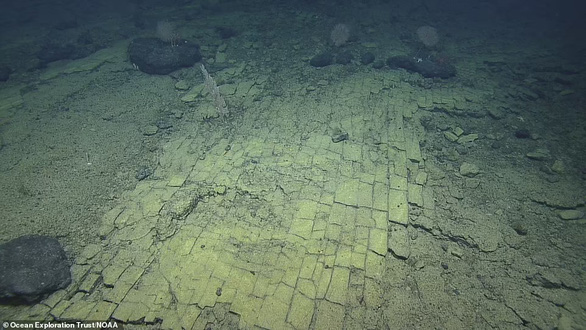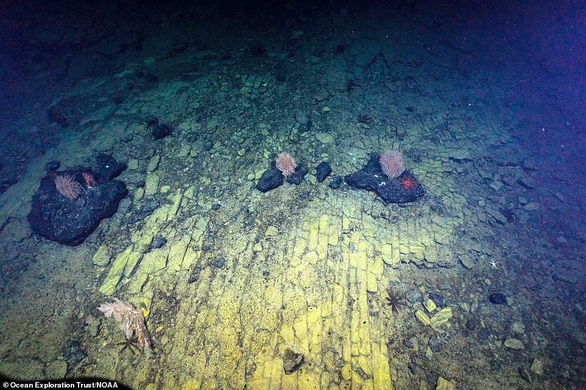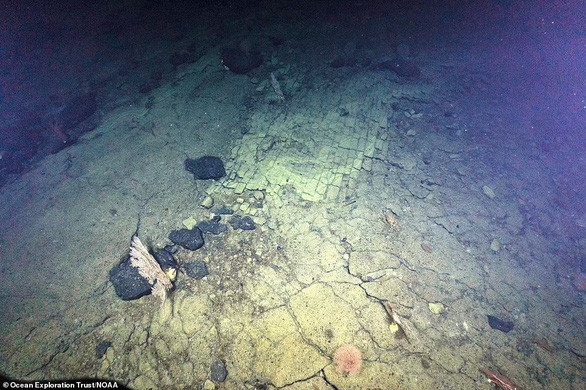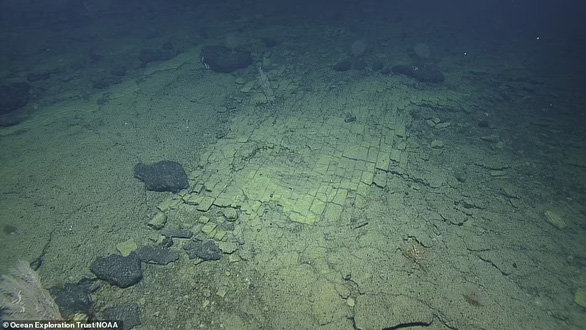Strange ‘brick road’ discovered on the bottom of the Pacific Ocean
A short clip of the “Yellow Brick Road” under the Pacific Ocean recorded by experts of the Exploration Vessel Nautilus research ship
During a seabed exploration dive in the area near the summit of Mount Liliاuokalani, in the waters of the Papahānaumokuakea National Marine Reserve in the Pacific Ocean (Hawaii), oceanographers from the research ship Exploration Vessel Nautilus was surprised to discover a strange geological formation.
Geological formations (geological formations or geological formations, formations, formations) are the basic units of stratigraphic lithographs. The concept of a formation in geological research includes a certain amount of rock strata with comparable petrographic and facies properties.
Studying the formations helps scientists to compare the correlation between geological strata.

The “yellow brick road” was recorded by experts of the Exploration Vessel Nautilus research vessel – Photo: Exploration Vessel Nautilus
In the clip recorded close-up, an oceanographer describes this geological formation as being exactly like bricks arranged neatly next to each other, like a long small “yellow brick road”, making people think immediately. The entrance to the legendary city of Atlantis.
The researchers identified this as a remnant of geological activity, a vivid example of the unique richness of tectonics of ancient volcanic activity.

The researchers identified this as a remnant of geological activity – Photo: Exploration Vessel Nautilus
Papahānaumokuakea National Marine Reserve is one of the largest marine protected areas in the world, with a surface area of 1,510,000 square kilometers.210 islands and atolls.
This area is highly appreciated for both cultural and natural values when there is a close relationship between people and nature. Not only has scientific and archaeological significance because it is home to hundreds of thousands of archaeological relics related to pre-European settlements, it also has cultural and spiritual significance with unique customs and identities. The place where it is believed that life begins and also where souls return after death.
In terms of marine science, researchers have only explored about 3% of its seafloor.

The main goal of the Exploration Vessel Nautilus expedition was to collect specimens to determine the geological origin and age of the seams and mountains to better understand the formation of the Northwest Hawaiian Islands. – Photo: Exploration Vessel Nautilus
The Exploration Vessel Nautilus research team has witnessed many unique and fascinating geological formations when diving in this sea with many “mountains”. At the Nootka Seamount, for example, they discovered a “dry lake bed” – now identified as a faulted outflow of hyaloclastite (a volcanic rock formed during high-energy eruptions where high-energy eruptions occur). many pieces of rock deposited and fell to the sea floor).
The team also documented many strange and large sea creatures that science has not yet learned much about.

Marine geological studies are important in providing signs of seafloor spreading and plate tectonics – Photo: Exploration Vessel Nautilus
Collecting samples to determine the geological origin and age of seamounts and mountains, especially to detect geological formations like this, can be valuable data for scientists, Geological studies better understand the formation of the Northwest Hawaiian Islands.
Marine geological studies are important in providing signs of seafloor spreading and plate tectonics. Not only that, the deep ocean floor is also an important object for detailed mapping in support of military (undersea) and economic goals (oil and metal mining).
Atlantis is a place name recorded in the writings of the famous Greek philosopher Plato around 400 BC and was an advanced civilization that ruled over a vast maritime empire. The city of Atlantis at the center of this empire is described as having a large enclosing wall with giant pillars at the entrance. It has a temple dedicated to the god Poseidon and giant circular islands inhabited by the Atlanteans.
It is thought that a natural disaster, such as a tsunami or volcano, wiped out the Atlanteans and the empire’s facilities. However, scientists have yet to find conclusive evidence that Atlantis ever existed, and many scholars believe that Plato created this myth as a way to present his philosophical theories.
at Blogtuan.info – Source: tuoitre.vn – Read the original article here



